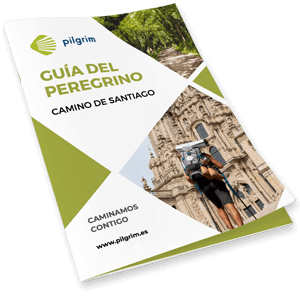Irún
‹ Back to the stage
Irún
- Residents: 61.195 aprox.
- Province: Guipúzcoa
Information
Get to know Irún
Irun is the starting point for those pilgrims who begin the Camino de Santiago on its northern slope.
It is located on the border with France and has always been a strategic point for trade relations with the outside world, and has also been proclaimed city of transport on numerous occasions.
Irun is the starting point for those pilgrims who begin the Camino de Santiago on its northern slope.
Irun is located on the border with France and has always been a strategic point for trade relations with the outside world.
Location
How to get there
Irun has a very complete public transport network, a fact that makes the city is connected to major cities in Spain and French cities. Irun’s train station offers many lines that communicate the city with Madrid, Barcelona, Lisbon, San Sebastian, Vitoria, Bilbao, etc. As far as buses are concerned, there are numerous lines that communicate the city with the rest of the autonomous community as well as with important Spanish cities.
By road it is also easy to access the city, the GI-636, GI-20 and the AP-8 freeway connect the entire northern peninsular with the city.
The airport of San Sebastian is close to Irun so it is also another option to reach the city, offers regular flights to Madrid and Barcelona and in summer time they extend the offer with flights to other Spanish cities such as Malaga and Palma de Mallorca.
<pHistory / Culture
What to see
Ermita de San Marcial
The Hermitage of San Marcial was built to commemorate the victory of the French in the battle of 1522. Years later the original temple was destroyed by fire so it was rebuilt in 1804 and the tower in 1910.
From the exterior of the temple it is worth noting a carved stone pinnacle with two tombstones that recalls the battles of San Marcial.
HOURS
Tuesday to Sunday from 11:00 to 23:00 Monday closed
From Tuesday to Sunday from 11:00 to 23:00 Monday
INFORMATION OF INTEREST
Phone: 943 645 458

Iglesia de Santa María del Juncal
The Church of Our Lady of Juncal was built in the sixteenth century and finished a hundred years later, in the seventeenth century, so its style mixes elements of the oldest Gothic with Basque Gothic. It was declared a National Historic-Artistic Monument in 1973.
The temple has a rectangular floor plan with three naves and a flat apse and a tower made of stone. The most remarkable of its exterior is the facade made with ashlar masonry and the Baroque façade of the seventeenth century, with regard to the interior include the Byzantine style image of the Virgin of Juncal XII century which is on the altarpiece.

Isla de Los Faisanes
The Pheasant Island belongs to both Irun and Hendaye and covers an area of 2,000 m2, it is stabilized thanks to the protection works that were carried out on it.
Among the many historical events that took place on this island the most recognized is the signing of the Peace Treaty of the Pyrenees. In the center of the island stands a monolith with an inscription explaining and recalling that event.

Casa Consistorial
The building that houses the headquarters of the Town Hall presents a baroque style of the eighteenth century. This had to be reconstructed in 1936 since the building during the Civil War was burned down.
<pFrom this set highlights its main facade for its austerity and symmetry and for having a portico with five semicircular arches made of ashlar masonry and groin vaults inside. This facade is topped by a balustrade ornamented with several fleurons, two bells, a coat of arms and on the second floor a balcony supported by the cover.
The interior of the building features a large central staircase of oak wood and a dome formed by 8 windows with stained glass windows representing the ancient historical territories of Euskal Herria.

Columna de San Juan de Harri
The Column of San Juan de Harri is built in stone with pedestal and although the exact date of its construction is not known, it is known that it was declared a Historic-Artistic Monument in 1964.
The Column of San Juan de Harri is built in stone with pedestal and although the exact date of its construction is not known, it was declared a Historic-Artistic Monument in 1964.
It has a fluted shaft which ends in a capital supported by coats of arms representing the House of Austria in Gipuzkoa and the University of Irun – Uranzu. At the highest point of the column there is a small statue.

Museo Romano Oiasso
The Oiasso Roman Museum is an archaeological space created with the aim of collecting the Roman remains found in the municipality of Irun known as “the old Oiasso” and disseminate the archaeological heritage found in this area.
An area of the museum is enabled to develop cultural activities related to Ancient History and Archaeology with the aim of making it an essential point of visit.

Palacio de Arbelaiz
The Arbelaiz Palace was declared a Provincial Historic-Artistic Monument in 1964 and is known thanks to the Arbelaiz lineage and the illustrious people who stayed there: Henry II of France, Catherine de Medici, Charles IV, etc.
The Arbelaiz Palace was declared a Provincial Historic-Artistic Monument in 1964.
After the fire of 1936 it was completely rebuilt giving it the appearance it has today, a rectangular house with ashlar stone. It is noteworthy that the original monument retains the Baroque facade with a door flanked by two Doric columns on which rests a frieze decorated with triglyphs and metopes and the pediment that frames the shield.

Ermita de Santa Elena
The Hermitage of Santa Elena is the only temple dating from the 10th century in Gipuzkoa. This temple was built on the site of the remains of a Roman church “in antis” dating back to the first century and the remains of an indigenous necropolis.
At present, the hermitage is used to house part of the Oiasso Roman museum, exhibiting inside collections of tools used in the daily life of the villagers.

Palacio de Urdanibia
The Urdanibia Palace was declared a Monumental Site in 2000 along with the mill and forge which are located in its surroundings. This building has a rectangular floor plan and is divided into three floors covered by a hipped roof. On the first floor there are two groined windows and in the center a door flanked by two pilasters topped with a cornice. The upper floors have the same windows as the lower ones but with molded sills to form a straight line.
It was the headquarters of the International Federation of Basque Pelota from 1992 to 2003.

Fuente de Santa Elena
The Fountain of Santa Elena is located inside a small baroque style building from 1667, which is composed of ashlar stone. This fountain has a basin and two benches, both structures covered by a barrel vault. In the central part of the vault is a shell-shaped niche with an image of Santa Elena.

Parque Natural de Peñas de Aia
The Natural Park of Peñas de Aia is a Paleolithic massif that preserves the oldest materials in the country and extends over 6,913 hectares of surface whose summits reach more than 800 meters.
It is worth mentioning the Urdaburu forest, the banks of the Añarbe reservoir and Arditurri, an old gold mine exploited more than two hundred years ago, which has a great archaeological and mineral wealth.

Hospital de Sancho de Urdanibia
The Hospital of Sancho de Urdanibia was built in 1644 thanks to the money donated by Sancho de Urdanibia with the intention of building a hostel-hospital. In the construction of the same masonry, ashlar masonry and separation platabandas between floors were used and its structure has a rectangular floor divided into three heights.
<pOn the main facade there is a niche with an image of the Virgin decorated with pilasters and topped by a pediment on which is the coat of arms of the house of Urdanibia.
It has now been fully restored and houses the Municipal Euskaltegi and the Menchu Gal exhibition hall.

Information of interest
Local police
943 505 555
Civil guard
943 627 836
Fire department
943 415 302 / 943 415 320
Civil protection
943 505 566 / 943 505 567
Town hall
943 505 152
Health center
943 006 700 / 943 617 888
Tourism office
943 020 732
Plaza de Luis Mariano

We send you your itinerary
Enter your details and receive your travel itinerary by email
Recommended
Gastronomy
Recommended
Festivals and Pilgrimages
Local festivity
30 de junio: Apóstol
Local festivity
4 de febrero: Fiesta de Santa Águeda
Local festivity
Primer fin de semana de mayo: Feria de abril
Local festivity
Mayo: Sagardo Eguna
Local festivity
25 de abril: Fiesta de la opilla
Local festivity
24 de Diciembre: Olentzero
Local festivity
21 de Diciembre: Fiesta de Santo Tomás
Local festivity
Primer sábado de agosto: Fiesta Euskal Jira
Local festivity
Segunda mitad de Julio: Festival Folclórico Internacional de Bidasoa
Local festivity
A finales del mes de julio: Dies Oiassonis
Northern Way
On foot
34 stages





































